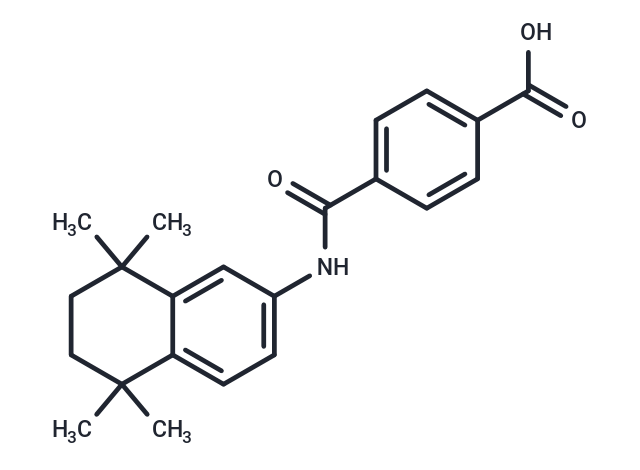Shopping Cart
- Remove All
 Your shopping cart is currently empty
Your shopping cart is currently empty

Tamibarotene (Amnolake) is an orally active, synthetic retinoid, developed to overcome all-trans retinoic acid (ATRA) resistance, with potential antineoplastic activity.

| Pack Size | Price | Availability | Quantity |
|---|---|---|---|
| 10 mg | $39 | In Stock | |
| 25 mg | $58 | In Stock | |
| 50 mg | $72 | In Stock | |
| 100 mg | $98 | In Stock | |
| 200 mg | $155 | In Stock | |
| 500 mg | $262 | In Stock | |
| 1 g | $389 | In Stock | |
| 1 mL x 10 mM (in DMSO) | $39 | In Stock |
| Description | Tamibarotene (Amnolake) is an orally active, synthetic retinoid, developed to overcome all-trans retinoic acid (ATRA) resistance, with potential antineoplastic activity. |
| In vitro | Tamibarotene treatment significantly reduces the levels of insoluble amyloid beta (Aβ) in the mice's brain, particularly Aβ(42), without notably affecting the levels of soluble Aβ. |
| In vivo | Tamibarotene induced HL-60 cell adhesion to endothelial cells was 38% lower compared to all-trans retinoic acid (ATRA). However, its ability to induce NB4 cell adhesion to endothelial cells was comparable to ATRA. In HL-60 cells, tamibarotene uniquely promoted early-phase induction of CD38 gene transcription through DR-RARE with intron 1 and late-phase induction through RARE lacking a 5' flanking region, resulting in lower CD38 induction than ATRA. Tamibarotene's growth inhibition on peripheral blood mononuclear cells was negligible, but it significantly inhibited growth in HTLV-I infected T-cell lines and ATL cell markers. It induced G1 phase cell cycle arrest and apoptosis in HTLV-I infected T-cell lines, inhibited phosphorylation of IkappaBalpha and NF-κB-DNA binding, reduced expression of proteins involved in G1/S phase cell cycle transition and apoptosis, and suppressed JunD expression, inhibiting AP-1 DNA binding. Tamibarotene slightly inhibited the growth of myeloma cells and HUVECs, and significantly inhibited VEGF-stimulated HUVEC growth. While having minimal growth inhibition on bone marrow stromal cells (BMSC), tamibarotene significantly inhibited HUVEC migration when co-cultured with myeloma cells and inhibited VEGF-induced phosphorylation of the VEGF receptor. Tamibarotene markedly suppressed the formation of in vitro tubular structures and neovascularization induced by VEGF in mouse cornea. |
| Cell Research | The CellTiter Aqueous Non-Radioactive Cell Proliferation Assay Kit is used to assess cell growth. Briefly, 10,000 cells per well are seeded in a 96-well plate and cultured in RPMI containing 2% charcoal-stripped FBS and indicated retinoid concentrations for 72 hours. At the end of the treatment period, the MTS reagent is added, cells are incubated an additional 2-4 hours, and absorbance is measured at 490 nanometers. |
| Alias | NSC 608000, Amnolake, Am 80 |
| Molecular Weight | 351.44 |
| Formula | C22H25NO3 |
| Cas No. | 94497-51-5 |
| Smiles | CC1(C)C=2C(=CC(NC(=O)C3=CC=C(C(O)=O)C=C3)=CC2)C(C)(C)CC1 |
| Relative Density. | 1.154 g/cm3 (Predicted) |
| Storage | Powder: -20°C for 3 years | In solvent: -80°C for 1 year | Shipping with blue ice. | |||||||||||||||||||||||||||||||||||
| Solubility Information | DMSO: 60 mg/mL (170.73 mM) 1.1eq. NaOH: 35.1 mg/mL (100 mM) | |||||||||||||||||||||||||||||||||||
Solution Preparation Table | ||||||||||||||||||||||||||||||||||||
1.1eq. NaOH/DMSO
| ||||||||||||||||||||||||||||||||||||

Copyright © 2015-2024 TargetMol Chemicals Inc. All Rights Reserved.